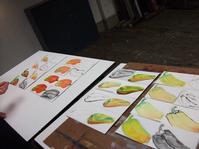When you look at a painting, can you tell if the paint is acrylic or tempera? When artwork in a gallery is called “mixed media,” do you start fretting about lazy cataloging? (Which media are being mixed, exactly? Tell me more, O anonymous author of wall text...). If you're reading a picture book to a cranky toddler, you’re probably not overly concerned with whether the illustrator used marker or pastel to create the colorful pages. But if you’re an archivist processing a children’s literature collection, figuring out just which material the artist used can keep you up at night. As archivists, we get the chance to work with many types of collections, and some of them require specialized expertise to classify correctly. That’s why one of our most important tools is research. And the best way to learn to identify art materials is to use them. We refer to this research as the “fun kind!”
Each of the authors and illustrators in the “Milestones in 20th Century American Children’s Literature” collections used a wide variety of materials and techniques. Some of the illustrators obviously used whatever was at hand and achieved the right effect (we're looking at you, Evaline Ness, and your paintings done with Wite-Out), without considering long-term preservation concerns. One of the challenges of processing these collections is identifying the nearly infinite number of supplies the artist could have used. Have you been to your local art store lately? You’ll find that the aisles are jam-packed with brightly colored paints and ink and pencils and markers and chalk and crayons and anything else you could possibly want. Could you pick tempera paint out of a line-up?
To better acquaint ourselves the materials involved in children’s book production, we visited the Fleisher Art Memorial for a crash course in illustration. Local artist and illustrator Thomas Leonard began by showing us many examples of finished illustrations in different media, including some of his own work, demonstrating the characteristics of certain materials. Acrylic paint, which became popular in the 1960s, often has a shiny finish and seems thin, while oil paint also has a sheen, but is much richer. We then had a hands-on look at how an artist uses different types of materials for varying results. Tom instructed us in the basic techniques and materials that we will come across when processing our collections, and then we drew and painted hot peppers using eight different media – pencil, charcoal, pen and ink, pastel, watercolor paint, tempera paint, acrylic paint, and oil paint.
Each member of the project staff has varying levels of art experience and knowledge. Our focus in the class wasn't to make masterpieces, but to try and see how the materials will look when they are finished. Rich layers of acrylic paint can be used to look like oil paint. When tempera is watered down it can look like watercolor. Seeing how charcoal smudges so easily not only helped us recognize it, but also warned us of conservation issues that might arise when we re-house these papers. When we were done, we each had a sample board that we were able to take back to the library and hang up for reference. The boards will serve as identification tools as we continue processing the collections, but they’ll also remind us of how much fun we had!
-Lindsay Friedman
Have a question for Free Library staff? Please submit it to our Ask a Librarian page and receive a response within two business days.




Michelle